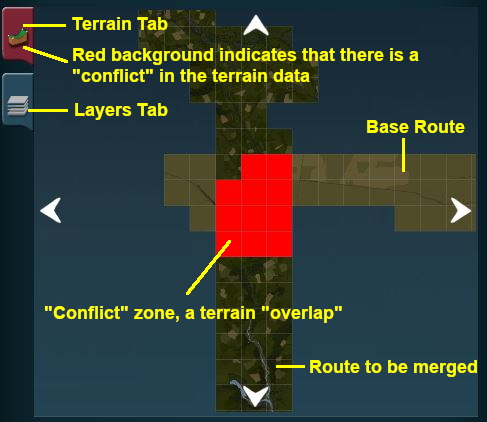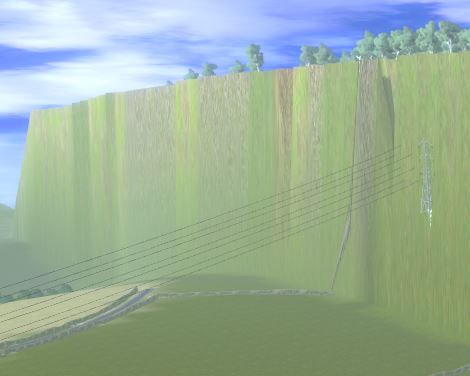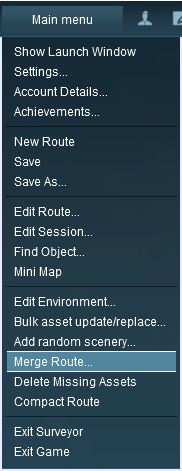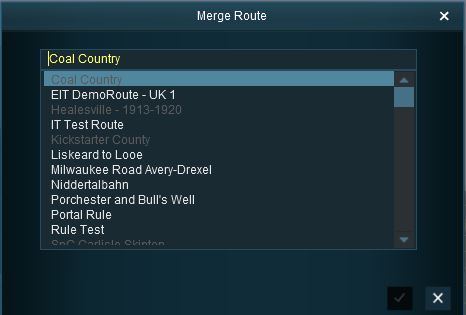How to Merge Routes
From TrainzOnline
(Difference between revisions)
(→Common Problems) |
(→Common Problems) |
||
| Line 24: | Line 24: | ||
<tr valign="top"> | <tr valign="top"> | ||
<td>[[file:DotPoint.JPG]]</td> | <td>[[file:DotPoint.JPG]]</td> | ||
| − | <td>'''Most route mergers will have problems.'''</td> | + | <td>'''Most route mergers will have problems but most of them can be fixed.'''</td> |
</tr> | </tr> | ||
</table> | </table> | ||
| Line 31: | Line 31: | ||
<tr valign="top"> | <tr valign="top"> | ||
<td>[[file:MergeHeightProblem.JPG]]</td> | <td>[[file:MergeHeightProblem.JPG]]</td> | ||
| − | <td> | + | <td> |
| − | * | + | *The easiest problems will be fixed as part of the merging process itself. |
| − | + | ||
| − | + | ||
| − | + | ||
| − | + | ||
| − | The | + | *The most common problem in the "hard to fix but do-able" category is when the two routes have been built at different heights or altitudes as shown on the left. The solutions to this will vary depending on the height difference. Common solutions are:- |
| + | **'''add extra baseboards''' between the two routes that will create an easy gradient from the ''base route'' level to the ''merged route'' level. The resulting track gradient should be compatible with the two routes. If the height difference is large then many additional baseboards may be needed. If the difference is too big then other options may have to be considered. | ||
| + | **'''use a spiral tunnel or ''switchback/zigzag''''' on a single extra baseboard to bring the track to the correct level. This would use a minimal number of extra baseboards. | ||
| + | **'''add portals to both routes''' so that a consist entering the portal on one route will emerge from the portal on the other route. Portals can have their own issues and this solution may not suit everyone and every layout. | ||
| + | |||
| + | *The most common problem in the "impossible to fix" category is when both routes have different orientations (N-S and E-W) and you were hoping to join them end-to-end in the same direction to make an even longer route. Once a route has been created its orientation cannot be changed. | ||
</td> | </td> | ||
</tr> | </tr> | ||
Revision as of 22:27, 4 July 2018
Contents |
Merging Routes
| The Merge Routes option in the Surveyor Main Menu allows two different routes to be joined together. |
Before You Start Merging
Before you start the merge there are some important points you will need to consider and there may be some preparation work that will have to be performed.
- Identify
- which route will be the base route that will form the backbone of the combined routes. This will usually be the larger route or the route that contains Session data that you want to keep in the merge.
- the route that will be the merged route that will be joined to the base route.
- the orientation (North-South or East-West) of the routes to be merged. Are they the same or different?
- exactly where the merge will occur in both routes.
- the height of the baseboards in the base route and the merged route at the merge point. Are they exactly the same height?
Common Problems
| Most route mergers will have problems but most of them can be fixed. |
Some problems will require you to do a bit (or a lot) of extra work before you can merge two routes into one. But for some problems, the best solution may be to select other routes to merge.
Selecting and Loading the Routes to Merge
- Load the Base Route into Surveyor
- Should you load the Route or the Session?
- The answer depends on whether or not a Session has been created for the base route and if that Session contains assets (scenery, consists) and settings (rules, driver commands, industry and wagon loads, weather, time of day, etc) that you want to continue to use in the new merged Route and Session. If the Session contains nothing that you need then load the Route only into Surveyor. Note that when you add the merged route only the Route assets and data will be loaded, no Session assets or data will be loaded.
- Should you load the Route or the Session?
This will merge the two routes and display a "minimap" of the new combined routes with some control options.
The Merge Map
 |
The Merge MiniMap has similar controls to the MiniMaps in the Driver and Surveyor.
In Terrain View:-
In the example shown on the left, the terrain conflict can be removed by moving the merged route to the left (clicking the left arrow) until the last red baseboard disappears. |
The merge will not proceed until ALL the conflicts have been eliminated.
- Move the merged route into its new position
- Move the merged route into its new position


